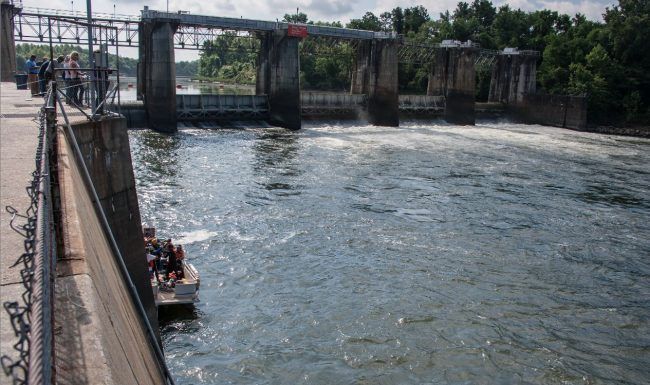Blog
Media Contact
Email: media@floodpanel.com

Aging Dams Post Threat Nationwide
Photo: AUGUSTA, Ga. – Divers with the U.S. Army Corps of Engineers Savannah District plunge into the Savannah River to inspect the New Savannah Bluff Lock and Dam, May 13, 2014. This was the first dive inspection performed on the aging structure since 1999. The divers assessed continuing erosion under the riverside lock wall, which has exposed supporting timber piles making them vulnerable to water damage and decay. USACE photo by Scott Hyatt.
During the 1950’s and 60’s the U.S. enjoyed a period of massive federal investment in the nation’s infrastructure. Bridges, roads, railways, and other transportation and energy-related systems were built or improved, and as a side benefit this investment created tens of thousands of jobs. The large expenditures on infrastructure, although difficult at the time, led to the very prosperous and economically stable decades that followed. In large part, this is because businesses were able to move goods and services via the best transportation system on the planet, and also because so many citizens had well-paying jobs connected to the public projects. The forward-thinking government that made the difficult appropriations necessary to build the infrastructure of this country also built the largest economy in the world.
Fast-forward many decades, and the U.S. economy is still coasting on those long-ago investments and sacrifices. During the 1960’s, which was the heyday of investment in infrastructure, the amount allocated from federal grants for infrastructural projects was close to 6% of the U.S. GDP. Today this investment rate hovers at around 3% of GDP. This means that while the demands upon our transportation and energy grid infrastructure has vastly increased, spending on these systems has been cut in half. Spending on infrastructure, while extremely critical to the nation and to the economy, is just not exciting or rewarding to the careers of the Congresspeople and Senators who must work to appropriate the funds. As Congress has grown ever more divided and partisan, the boring and un-newsworthy infrastructure investment has languished.
This neglect is not only a figurative ticking time bomb for the economy, but is also a literal life-and-death matter for many U.S. citizens who drive across crumbling bridges, transport goods through declining underwater tunnels, and live downstream from aging dams. While all of these issues are critically important, it is the aging dam issue that we will consider today.
Dams have been in use in the U.S. since the very first human inhabitants arrived. Native Americans made use of natural beaver dams to aid with agriculture, and soon began to construct their own. Dams have been used to power mills for thousands of years, and in the late 1800’s the first hydroelectric dams went into service in England and the U.S., very soon after humans learned to harness electricity. There was a rush to build hydroelectric dams, and this new method of energy production seemed limitless and thrilling. Funds were allocated enthusiastically for this novel and hugely useful new technology. Perhaps the culmination of this great dam-building age was the breathtaking feat of engineering called the Hoover Dam.
Today, however, we take all these elderly dams for granted. In the U.S. today, there are countless small dams that have been blocking flowing water for over a century. One hundred (or more) years of water flowing over packed earth, fitted stone, or even the strongest concrete structure can inflict a lot of damage. The great enthusiasm for building the newfangled hydroelectric projects gave way to a much more subdued interest in maintaining the dams. Now, the U.S. faces a looming crisis of decrepit dams that may lack the integrity to withstand the increased pressures that are arising from climate change.
Those responsible for inspecting the nation’s dams have been sounding the alarm for decades, only to be ignored. However, as climate change brings heavier and more frequent storms, community leaders have been forced to pay attention to the floods that occur with ever-increasing frequency. Today it has become so common for dams to be breached during storms that many homeowners are forced to invest heavily in flood mitigation measures such as extensive landscaping, flood barriers, fortified sump pumps, and even elevation of the entire structure. But even this is not the worst of the matter. Many people who live downstream from crumbling dams have much more to fear than flooded basements and blocked roadways. If a dam fails suddenly, all those below the dam are at extreme risk of losing their very lives!

